Last week I was in Austin, Texas to give one of my favourite talks, about using art in a garden. I was there as part of a series called Garden Spark, arranged by writer and gardener extraordinaire, Pam Penick. (You can find her regular blogs at www.penick.net/digging)
The talk was held outdoors at Barton Springs Nursery, an ideal location since audience members could stock up on plants beforehand — and there were lots of interesting plants to choose from.
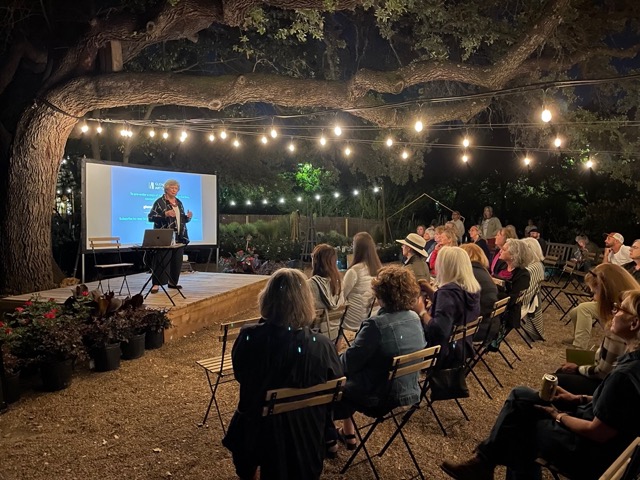
A bonus was the sweetly-scented wisteria in full bloom near the stage.

As much as I enjoyed the trip, I have to acknowledge that it was a shock to my system to go from this …
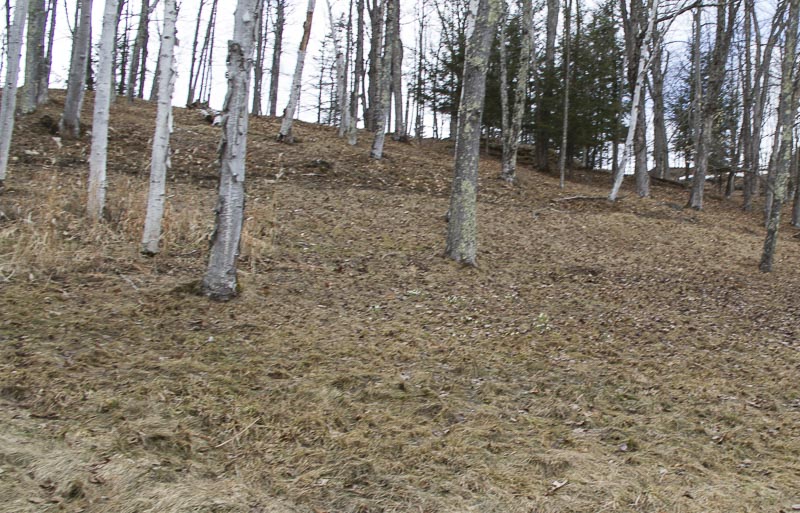
My garden at the end of March. If you look closely, you can see a few snowdrops just beginning to bloom.
to this …
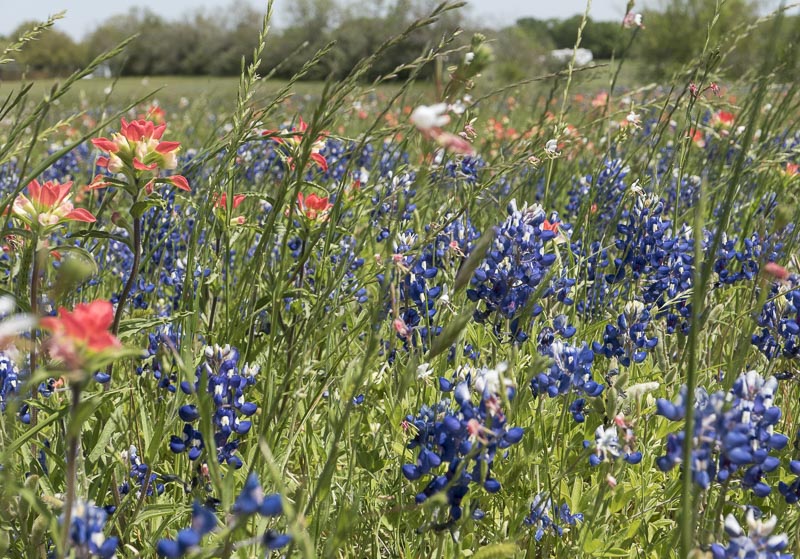
Texas wildflowers in early April: bluebonnets and Indian paintbrush.
and back to this.
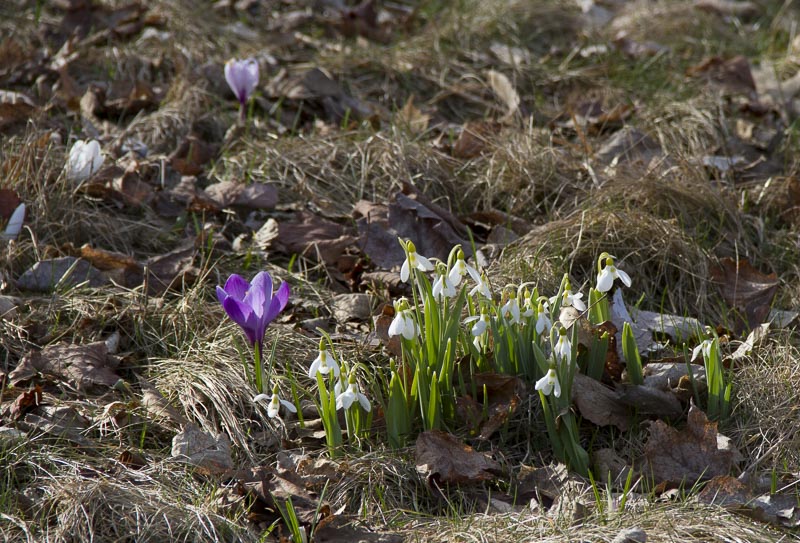
Crocus were blooming when I returned, and the snowdrops were still going strong.
But what a great trip it was! Pam was an excellent host and Austin was an eye-opener. People had told me it was an exciting, dynamic city, full of interesting street art, and driving through the downtown made that clear.
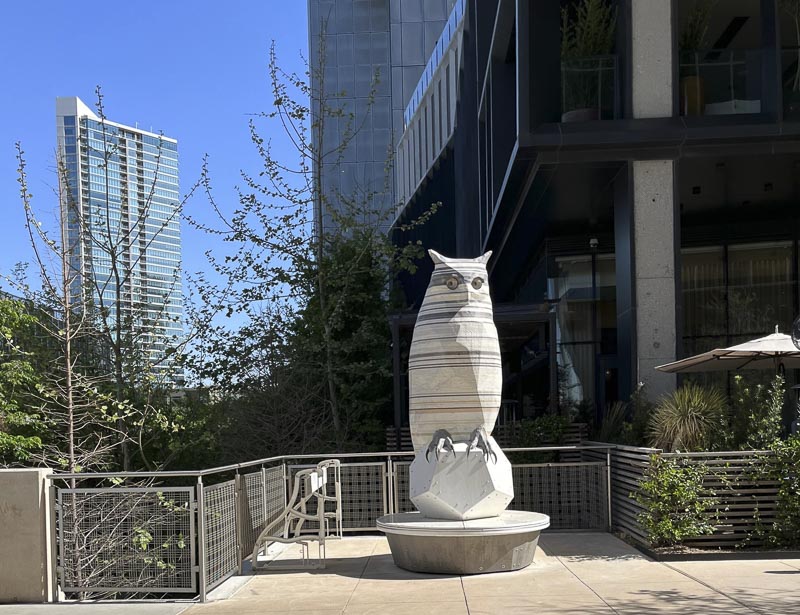
I don’t know the name of the artist or the significance of the owl. I do know that I like it.
The state capital building was impressive, …
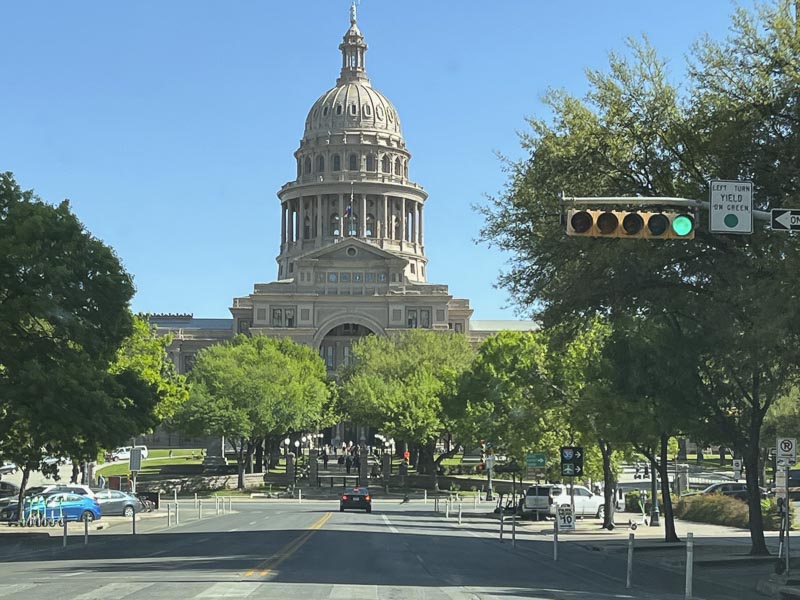
The architecture tells an observer that this is an important building.
… and the political sentiments not necessarily what I’d expected …

but loyalty to the Lone Star State confirmed what I’d been told. Texans are proud of their state, and that pride was displayed in stars repeated everywhere.
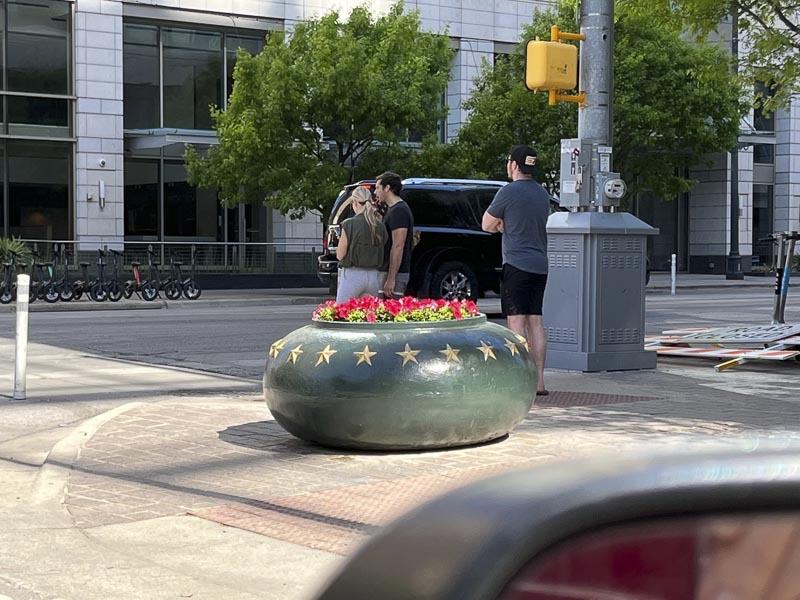
This planter is just one example of the ways that stars are used in Texas.
Still, I wasn’t prepared for the full-on Texas experience.
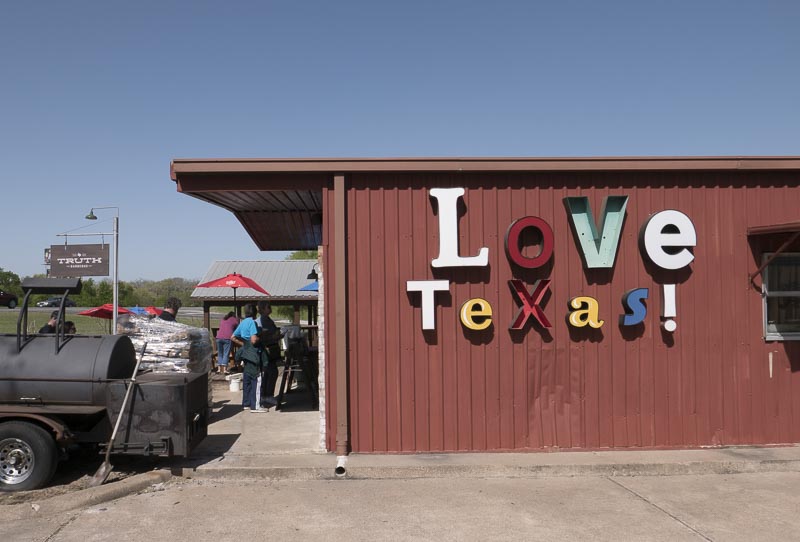
After tasting barbecue, Texas style, at this popular spot east of Austin, I understand why Texans love it.
Pam, her friend Diana Kirby and I spent a day east of the city enjoying the wildflowers. They weren’t as good this year as some years because of a drought last fall, they told me. But if this year wasn’t a good one, you could have fooled me.
Field after field was hazed with blue (Lupinus texensis), intensified by dots of orange Indian paintbrush (Castilleja indivisa).

At one location, an old log cabin added a western touch.

Taking photos of the wildflowers isn’t easy. Stopping by the side of the road can be dangerous and Texans aren’t fans of trespassing or trespassers. But with Pam at the wheel, we found lots of good spots to pull over for the obligatory photo op.
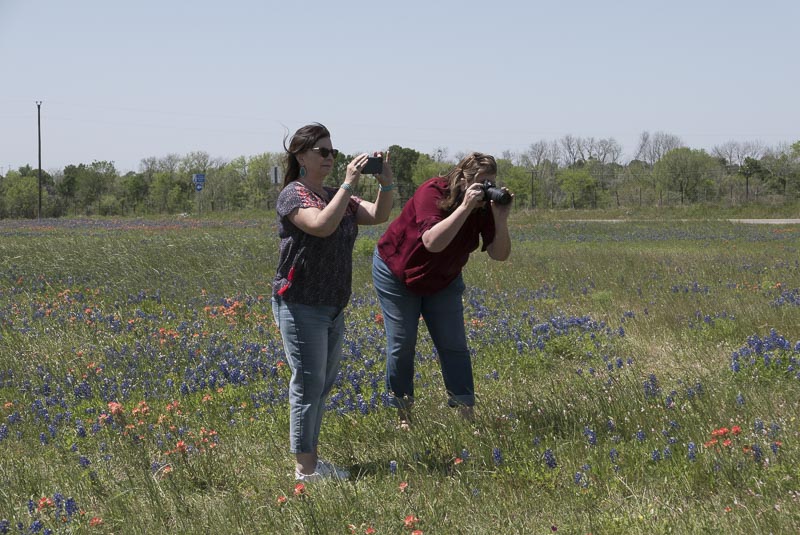
Diana and Pam must have thousands of photos of the wildflowers — it’s an annual display.
Over three activity-packed days, I visited several nurseries and gardens, the Lady Bird Johnson Wildflower Center and Pease Park, Austin’s oldest public park, where I was fortunate enough to hear a lecture given by Christine Ten Eyck, an Austin-based landscape architect whose firm has made significant improvements to the park.

The image on the screen shows a sketch for the park’s Treehouse, designed to suggest a seed pod.
On a pleasantly warm evening, the park was full of runners and loungers, stretched out on the grass, along with some adventurous couples jumping on the Treehouse netting. Of course, I had to have a go.

How could I resist?
I saw far too much in and around Austin to chronicle in a single blog post but I do want to share some photos of an exhibition at Pease Park.
The Blue Trees are a temporary installation by Konstantin Dimopoulos, a conceptual artist and sculptor whose work examines questions related to ecology and the human condition.
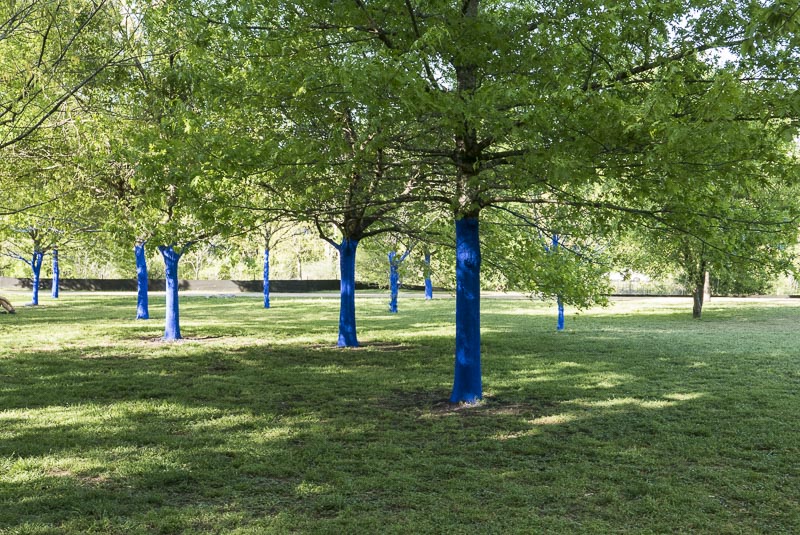
Following his directions, volunteers painted tree trunks Majorelle blue on two sites in the park, a grassy common and a wooded grove. This isn’t the first time Dimopoulos has done this, nor is Austin the first location. Blue trees have appeared in six other U.S. states, in Australia, Germany and, in Canada, in British Columbia and Ontario.
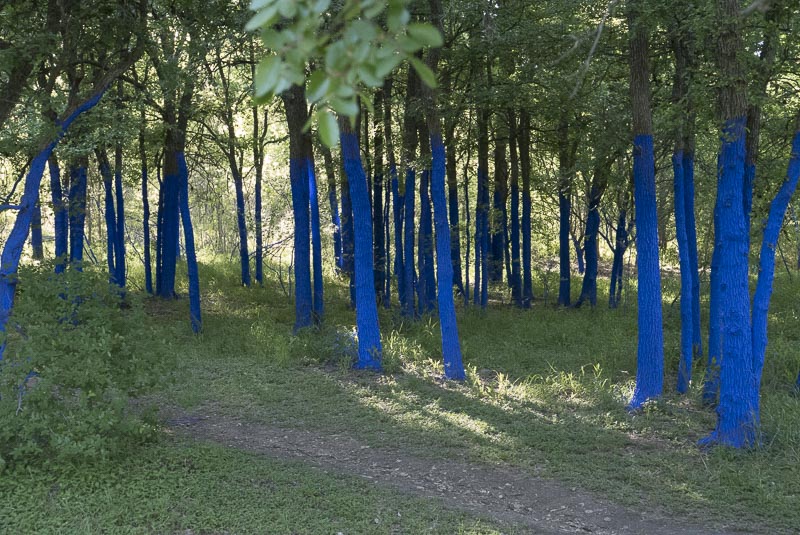
Art as a means of social engagement is a concept I support. But did this exhibit meet its goal of highlighting ecological issues, such as the destruction of forests and climate change?
There is no doubt that the blue trees are striking. No one passing can ignore them. And that ‘call to attention’ accomplishes something worthwhile — looking closely at the trees reveals interesting variations in the bark and in the shapes of the trees themselves. Most were tall and straight; others leaned gracefully. One even held a rock between its split trunks.
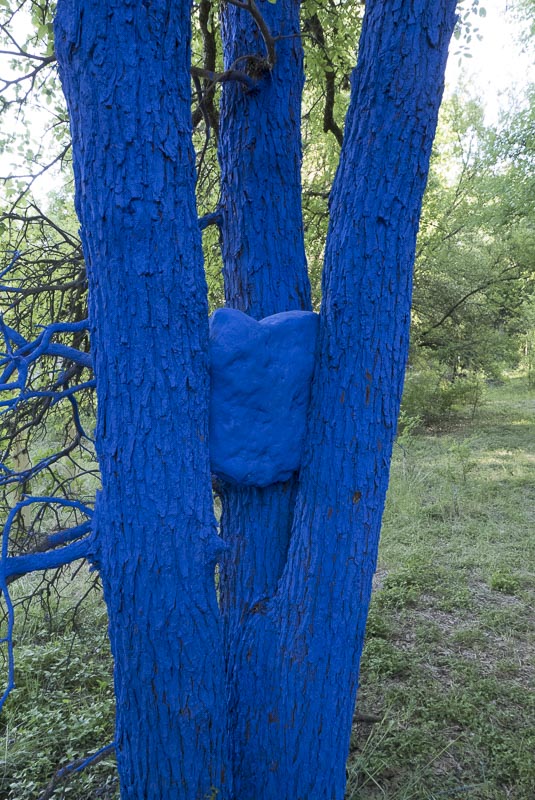
The paint does no damage and will fade over time. As the seasons pass, the aesthetic effects of the colour will change. This idea, that the changes illustrate the passage of time, is a significant concept in environmental art. Ideally, the changes will lead us as observers to consider how our actions shaped our personal environments in the past and how what we do today will shape the future.
Some in the Austin area are speaking out against Dimopoulos’s project as an unnecessary desecration of the natural beauty of the trees. Others are supporters.
There are many ways that you can interpret the installation. You can see it as an aesthetic experience, or as underlining the ephemeral, fleeting quality of nature, or as a call to environmental action.
So I ask you, how do you respond to the Blue Trees? What do they make you think of? Or do they make you think at all?







How fun to see your take on Austin, Pat! But even more fun was having you here to speak — great talk, btw! — and seeing the spring sights with you. Thanks so much for coming to Austin. And now you get to enjoy a second spring! 😉
If you’d like to know more about the owl sculpture, I have a blog post about it: https://www.penick.net/digging/?p=68995
Pat, I just loved this post. And I’m so glad that you were able to be in Austin in person. It’s a MUCH bigger city now, compared to the place I grew up in and went to university, but I know from a not too long ago Garden Bloggers Fling that it continues to be a happening place. And spring with bluebonnets and Indian paintbrush. Perfect.
My Quebec friends are still quite in winter mode, while here in North Carolina, it’s fully in early spring. Quite the contrast, just like you experienced.
Love the blue trees. Made me wonder about our wood…… Don’t know quite what it gives in terms of any ‘message’ though.
I like the blue trees, awareness of the environment is always good as it brings people to think
How fun to see your take on Austin, Pat! But even more fun was having you here to speak — great talk, btw! — and seeing the spring sights with you. Thanks so much for coming to Austin. And now you get to enjoy a second spring! 😉
If you’d like to know more about the owl sculpture, I have a blog post about it: https://www.penick.net/digging/?p=68995
I will check out the blog post, Pam. Thanks for the link. And congratulations on your piece in Better Homes and Gardens. That’s a big publication, with a lot of history and what I imagine must be a huge circulation. Well deserved.
Pat, I just loved this post. And I’m so glad that you were able to be in Austin in person. It’s a MUCH bigger city now, compared to the place I grew up in and went to university, but I know from a not too long ago Garden Bloggers Fling that it continues to be a happening place. And spring with bluebonnets and Indian paintbrush. Perfect.
My Quebec friends are still quite in winter mode, while here in North Carolina, it’s fully in early spring. Quite the contrast, just like you experienced.
Yes, the contrast is striking, and not only in terms of weather. Austin must have been a good place to grow up. I loved seeing the wildflowers, the Lady Bird Johnson Wildflower Center and so much more.
Love the blue trees. Made me wonder about our wood…… Don’t know quite what it gives in terms of any ‘message’ though.
The effect is really striking but I agree, I’m not sure what message is being sent, if any.
I like the blue trees, awareness of the environment is always good as it brings people to think
Thanks for sharing your view, Louise. That is clearly the artist’s goal.
I would not have known that the painted trees were intended to highlight “ecological issues, such as the destruction of forests and climate change” if you hadn’t told me. If the artist has to tell you what the art signifies in order for you to “get it”, is that art successful? I happen to like that color blue, but painting trees turns them into objects for me, obscuring rather than highlighting that these are living beings essential to our own survival. I certainly don’t feel called to environmental action by seeing trees painted.
So far the feedback is tipping in your direction, Kathy. And your comments are right in line with those in Austin who are opposed to the project. Your suggestion that painting trees turns them into objects is really interesting. I’ll have to think more about that.